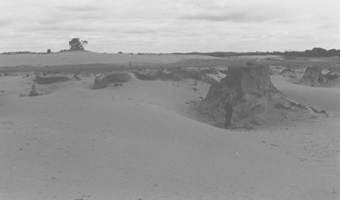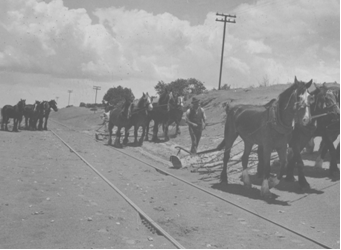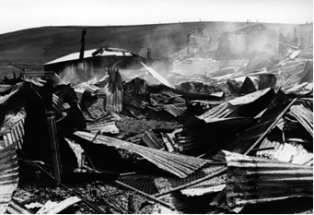Natural disasters
Primary producers and their rural communities constantly live with the risk of natural disasters. Generally, disasters are difficult to predict and to mitigate.
The Department of Agriculture has for many years played a key role in assisting farming communities through the response phase of natural disaster and a lead role in the ensuing recovery. This natural disaster section contains information about:
- drought
- bushfires
- floods
- severe weather events
- legislative and policy structure
- support for community recovery.
The Department, in collaboration with the primary industries and rural communities, also responds to weed, pests and disease incursions.
Coping with the vagaries of the weather during the early colonial days
Natural disasters have struck agriculture in a number of ways since colonisation. They can be very local and wreak enormous damage to a few farms in a small area or extend across the whole State. For example a quote from the Bureau of Meteorology website provides insight into the early weather disasters in South Australia.
From the very beginning of the colony, the summer heat was a great concern to the new settlers, and heat exhaustion was common. On the inaugural Proclamation Day, on December 28, 1836, the shade temperature had allegedly been over 100°F (40°C) for 4 consecutive days (Corbett, 2002).
The hot summer of 1850-51 caused a severe water shortage that badly disrupted the shipment of wheat and copper ore. Also, many valuable animals were lost . The drought continued until the end of April when 33 mm (1.5 inches) of rain fell in Adelaide. This was followed by 163mm (6.5 inches) in May and, by the beginning of spring, Adelaide had recorded 20 inches since the break of the drought in April. The rain was heavier in the hills and to the south of Adelaide, resulting in flooded creeks and boggy roads. To add to the misery of the weather, unemployment also was running high at the time and many left SA for the Victorian goldfields.
Heavy rains in October 1853 caused local flooding in the Barossa Valley and the village of Hoffnengthal had to be abandoned after being settled 6 years before in 1847 by 20 German migrant families.
– First published: Bureau of Meteorology
Drought
Drought has periodically devastated cereal and livestock industries leading to spin offs to other sectors through resulting shortages of grains for stock feed and down turns in regional economies. At times their severity has been extenuated by overstocking or, as in the early days of the colony, cropping in areas with insufficient average rainfall to sustain an industry over the long term.
Failure of the opening rains followed by a below average spring results in dramatically reduced crop yields and pasture growth leading to low yields and shortage of feed for livestock forcing up the price of how and feed grains.
Droughts in the 1800s resulted in Parliamentary investigations and government funded drought support measures. The most severely impacted areas were those where cropping had extended into the lower pastoral country to the north and the marginal mallee type country.
Goyder’s Line was established in 1865 as a demarcation as a guide to the northern extremity of cropping land, although improvements in farming practices has since allowed successful enterprises “beyond the line”.
State and Federal government assistance to farmers has been provided during most major droughts.

Soil erosion at Mindarie 1967

Clearing drift sand from a railway line in the 1940s.
In the times when transport of stock was difficult and the excessive numbers of stock could not be handled by processing works, governments have provided various subsidies such as for freight and fodder. More recently the assistance has been focussed on financial assistance such as interest rate subsidies to ensure the farmers can make their own financial decisions on how to manage to crisis. The Rural Assistance Branch has a long history of managing various assistance schemes.
Extension advice has also been a key aspect of the Department’s drought role. Livestock feeding and management advice has been provided to help farmers make optimum use of scarce on farm feed reserves and expensive purchased feeds. Advice on cropping practices and financial management has also been important.
Fire
Fires are a constant risk on farming properties and cause significant losses of fences, sheds, machinery, livestock and homesteads. Over the years, there have been a number of disastrous bushfires which have impacted on large areas of the State including 1939, 1951, 1955, 1958, 1959, 1983, 2005, 2015, 2019 and 2021.

Damage to property and livestock after the 1983 Ash Wednesday fires was extensive
Following the disastrous Kongorong fire in January 1959, the State Government formed the Bushfire Research Committee to investigate economic land use methods to minimise the effects of bushfires, research on fire dynamics, and to advise landholders on the best methods to reduce fire losses. The Department of Agriculture’s representative was Barry Graham. Reports of the activities of this group are available at:
- Agronomy Branch Report – a summary of bushfire research, 1964-1974
- Agronomy Branch Annual Report – 1976-77 (pages 10-13)
The Department’s key role is immediately following a fire when teams of staff assess the damage, prepare reports and advise and assist farmers with stock destruction and environmentally sound disposal of carcases.
After Ash Wednesday, in February 1983, the role as an essential service was recognised by the State Disaster Organisation and the Department became a member of the organisation, appointing a State Controller of Agriculture and Animal Services, with regional support. To some extent this formalised the role played by the Department for many years before.
For more recent fires, for example the Wangary fire (2005), Sampson Flat fire (2015), Pinery fire (2015), Cuddly Creek fire (2019) and Kangaroo Island fire (2020), the Department has played an increasingly important role in overseeing or contributing to the recovery activities for a 1-2 year period following the fire event.
The other noticeable change over the past two decades has been the collaboration between industry, via their organisations, and Government in the response and recovery activities following a natural disaster.
Floods
Floods tend to be of a local nature and impact a small number of properties in a severe manner. The 1870 and 1956 River Murray floods were the most disastrous flood events in South Australia. With irrigation settlements scattered all along the River Murray, flooding caused immense damage to crops and infrastructure. The book “Floods in South Australia” chronicles all recorded floods since 1836 to 2006. Rarely is any mention made of agricultural loss such as crops or livestock even though they have been significant for individuals on numerous occasions.
Some floods are of a regional nature. A recent example is the Gawler River flood of 2006 which destroyed over $40m of vegetable crops and property infrastructure on Adelaide Plains. The Department of Agriculture (now PIRSA) played a key role in coordinating response to this disaster while it was occurring and follow up community relief during the recovery phase.
Storms
From time to time, localised storms wreak havoc in particular districts or on specific industries. A good example is a series of hailstorms that destroyed large areas of glasshouses on the Adelaide Plain in the late 1970s and early 1980s. Localised windstorms can also be devastating in districts such as occurred when a tornado ripped through a large area of vineyards near Renmark in 2005 and again in 2016.
Severe unseasonal frosts can also be devastating for grain growers and horticultural industries.
Legislative and policy structure
Prior to the 1970s emergencies were generally responded to via acts of Parliament. This particularly applied to droughts, pest incursions and floods. The Department of Agriculture played a major role in working with primary producers to manage the response and recovery arrangements.
In 1975 the Dunstan Government via a Cabinet decision established the State Disaster Committee to develop a plan to deal with a major disaster or emergency in South Australia. It established the Emergency Management Council (a Cabinet committee), the Emergency Management Standing Committee and the State Disaster Committee.
In 1980 Parliament passed the State Disasters Act to provide the legal backing via declarations of emergencies. The Department of Agriculture was not involved in the structural arrangements set up under this Act however maintained a clear operational responsibility for working with primary producers and the rural community to minimise the impact of these events. Structural arrangements were maintained.
Following the major Ash Wednesday bushfire in 1983, more agencies, including the Department of Agriculture, were members of the emergency management arrangements. The assignment of State Controllers was introduced with the Department of Agriculture holding the position of State Controller, Agriculture and Animal Services.
With the emerging terror threats in SA, following a series of major incidents within Australia and overseas, the Government undertook a review of the emergency management arrangements which resulted in the passing of the Emergency Management Act of 2004. This Act contained the following major provisions, in terms of PIRSA’s involvement in emergency management:
- The Standing Committee and State Disaster Committee was replaced by the State Emergency Management Committee
- The focus changes from disaster management to an “All Hazards” approach
- Emergency Management Zones were established with their own regional committees
- Recovery was recognised in the Act with the appointment of a Recovery function with a specifically assigned Minister and senior staff.
As a result of these legislative changes PIRSA was responsible not only for the Agriculture and Animal Services, but was also the Hazard Leader for this function. It particularly included animal welfare roles and responsibilities.
Community recovery
Over the last century, the Department of Agriculture has played a key role in coordinating community and Government responses to natural disasters, providing technical advice to farmers on how to deal with particular abnormal circumstances, and supported communities during the recovery phase.
From time to time, State and Commonwealth governments have provided financial support to rural communities during recovery from natural disasters. The Department of Agriculture’s Rural Assistance Branch (renamed the Rural Finance & Development Division (RF&D) in 1990) has played a key role in administering these financial relief measures.
Some of the assistance that has been provided includes:
- subsidy payments to farmers to provide interest rate relief on commercial farm debt and to improve productivity
- re-establishment grants to assist adjustment out of farming
- grants for farmers to obtain farm financial and management advice and education and training
- increased linkages and access to other Rural programs such as National Land Care Program and the Natural Heritage Trust through regional strategies
- exceptional circumstances interest rate relief for areas declared to be experiencing hardship as a result of adverse seasonal conditions/industry downturn.
The Commonwealth Government, in conjunction with the State Government provides financial support in the event of an emergency (floods, storms, fires and adverse weather events). The programs have had different titles over time and implemented by different agencies. The National Recovery and Resilience Agency provides funds to assist recovery after an event. The Federal Agriculture agency supports primary producers in times of drought.
At both the State and Commonwealth levels there has been a significant redirection of funding for emergencies, away from financial handouts to programs that build individual and community resilience to better recover from emergencies that occur.
